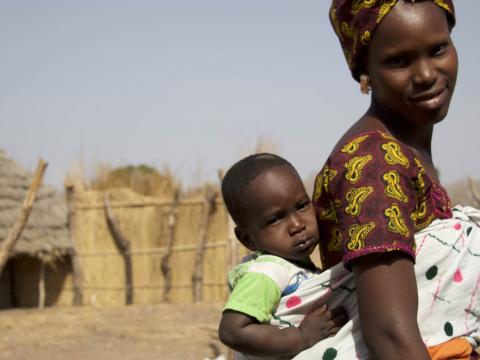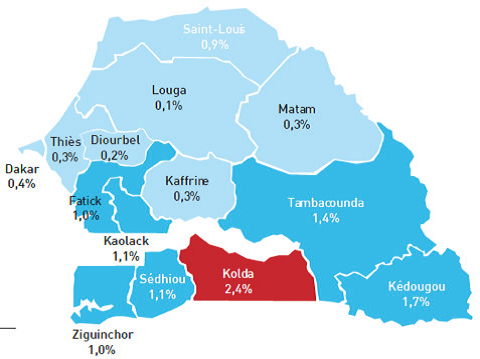World AIDS Day

17 million children worldwide have been orphaned by AIDS*. With more than 36 million fatalities to date, HIV continues to present a major public health challenge. In 2015 alone, 1.1 million people in the world died of HIV-related illnesses*. By the end of 2015 it was estimated that around 36.7 million people in the world were living with HIV, of which 2.1 million were new infections*. Sub-Saharan Africa is the worst affected area, where 25.6 million people were living with HIV in 2015*.
HIV prevalence in Senegal stands at 0.7% of the overall population (see map below), an index that remains stable thanks to combined efforts to prevent, treat and support sufferers.
One of World Vision’s key actions in the prevention of mother-to-child HIV transmission has been to promote voluntary testing for women of child-bearing age and teenagers. Every day 1,068 babies are born HIV-positive or acquire this status during the breastfeeding stage.
Total elimination of mother to child transmission of the virus - an achievable objective
For the first time, the elimination of the risk of HIV transmission from mother to baby is regarded as an achievable public health objective, and consequently a large part of the campaign to reach the Sustainable Development Goals was devoted to it. According to recent estimates, 36,379 people in Senegal were living with HIV in 2013, of which 4,591 were children under 14. Female AIDS sufferers accounted for 61% of adults, and the number of deaths attributable to AIDS stood at 1,800**.
New directives published by the World Health Organisation urge the prolonged use of anti-retroviral medication during pregnancy, and they recommend that HIV-positive mothers and their children take anti-retrovirals during breastfeeding for at least 12 months. These recommendations should drive down mother and child mortality rates and prevent the spread of HIV.
To put an end to the AIDS epidemic by 2030, the Heads of State of the African Union have committed themselves to the following, which are reflected in Senegal's Strategic Plan 2014-2017:
- Zero new infections
- Zero AIDS-related deaths
- Zero discrimination
AIDS sufferers, HIV-positive people, groups at high risk of HIV, and vulnerable communities have been placed at the heart of this response.
Significant economic and cultural barriers remain
95% of HIV-positive people live in developing countries, where poverty is one of the first barriers that prevent many HIV-positive mothers from accessing healthcare services.
Equally, barriers may be cultural - taking the form of limited awareness of methods to prevent transmission of the virus, or traditional child-rearing practices based on breastfeeding.
World Vision action
Prevention of mother-to-child transmission of HIV is built into World Vision’s development programmes:
- Implementing basic measures to prevent HIV by training the community on the spread of HIV/AIDS;
- Organising voluntary mass testing programmes;
- Providing information about modern contraceptive methods to prevent unwanted pregnancy;
- Ensuring availability of prenatal check-ups at health centres as part of an advanced strategy;
- Offering support for HIV sufferers to meet their nutritional needs
Get on board with the World Vision campaign ‘Health – kids first!’ to encourage our leaders to act in favour of mother and child health.
* Source: Joint United Nations Programme on HIV/AIDS (UNAIDS)
** Estimates and projections by EPP Spectrum 2013, Senegal (estimates and projections released by Spectrum 2013 – version 4.58) – UNAIDS, National AIDS Control Committee of Senegal.
Photos Credits : Delphine Rouiller
